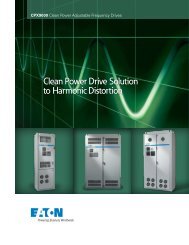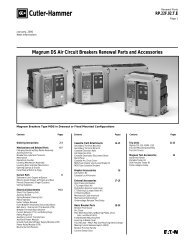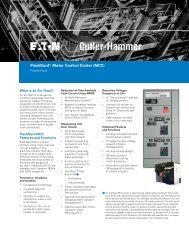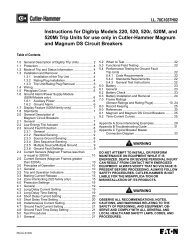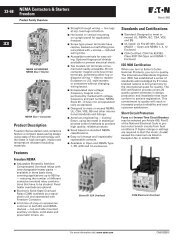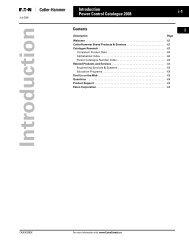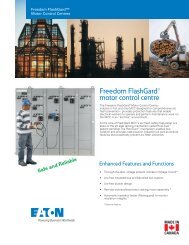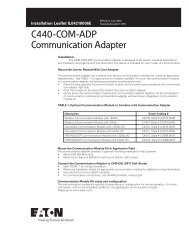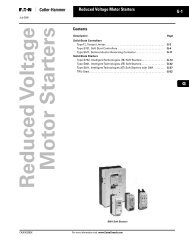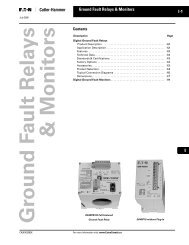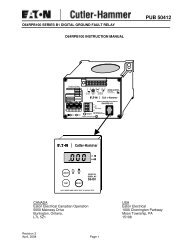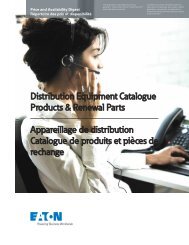Cutler-Hammer Busway Systems - Eaton Canada
Cutler-Hammer Busway Systems - Eaton Canada
Cutler-Hammer Busway Systems - Eaton Canada
Create successful ePaper yourself
Turn your PDF publications into a flip-book with our unique Google optimized e-Paper software.
<strong>Cutler</strong>-<strong>Hammer</strong><br />
Plug-in Protective Devices<br />
All Pow-R-Way and Pow-R-Way II plugin<br />
units (both circuit breaker and fusible<br />
types) have the following features:<br />
Personnel Safety (See Fig. 1)<br />
Plug-in units have a dual purpose interlock<br />
to prevent cover from being opened while<br />
the device is in the “ON” position and to<br />
prevent accidental closing of the device<br />
while cover is open. This dual purpose<br />
interlock may be defeated if necessary for<br />
maintenance.<br />
The plug-in unit and the busway are<br />
interlocked to ensure that the device is in<br />
the “OFF” position prior to installation or<br />
removal from the unit (Fig. 2).<br />
The plug-in enclosure is grounded to the<br />
busway housing before the phase and<br />
neutral stabs make contact with the busway<br />
bus bars.<br />
The operating handle remains in control<br />
of the disconnect device at all times.<br />
All plug-in units are polarized to make it<br />
impossible to put plugs on backwards and<br />
have neutral stab touch a phase bar.<br />
The clamp and guide are designed to<br />
allow plug-in units to be hung in place on<br />
horizontal runs prior to insertion of stabs.<br />
Flexibility (See Fig. 3)<br />
Two-position handle location allows<br />
handle to be mounted on the end of the<br />
unit for horizontal runs or on the side of<br />
the unit for vertical runs.<br />
Neutral stab and ground stab are field<br />
mountable.<br />
Backfeeding is an industry-acknowledged<br />
practice whereby incoming power is fed<br />
into the load side of a plug-in unit to feed<br />
a busway run. UL permits “backfeeding”<br />
a circuit breaker, providing it has a noninterchangeable<br />
trip or is a Seltronic-type<br />
breaker.<br />
UL will not permit “backfeeding” a<br />
TRI-PAC ® type circuit breaker or a fusible<br />
plug-in device.<br />
Using <strong>Cutler</strong>-<strong>Hammer</strong> Series C circuit<br />
breaker bus plugs, system interrupting<br />
ratings can be increased up to 100K AIC<br />
(480V) or 200K AIC (240V) when F-(150A),<br />
J-(250A), or K-(400A) frames are used. By<br />
changing out the breaker only and leaving<br />
the enclosure intact, this allows for<br />
flexibility to deal with system short circuit<br />
availability changes (up to the rating of<br />
the busway), as well as downstream protection<br />
through series ratings.<br />
March 2001<br />
Dual Purpose<br />
Interlock<br />
Neutral<br />
Stab<br />
Ground<br />
Stab<br />
Fig. 1. Open View Plug-in Units<br />
Interlock<br />
(Accessible)<br />
Fig. 2. Plug-in Unit Mounted on <strong>Busway</strong><br />
Handle Mounted for<br />
Horizontal Run<br />
Fig. 3. Universal Handle Mounting<br />
Application Data<br />
30-560<br />
Page 23<br />
Pow-R-Way ® <strong>Busway</strong> <strong>Systems</strong><br />
Interlock Defeater<br />
Interlock<br />
(Not Accessible)<br />
Handle Mounted<br />
for Vertical Run<br />
Load End



